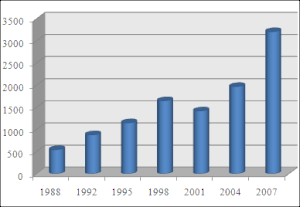The foreign exchange market is the largest and most liquid financial market in the world. Traders include large banks, central banks, currency speculators, corporations, governments, and other financial institutions. The average daily volume in the global foreign exchange and related markets is continuously growing. Daily turnover was reported to be over US$3.98 trillion in April 2010 by the Bank for International Settlements.[3]
Of the $3.98 trillion daily global turnover, trading in London accounted for around $1.85 trillion, or 36.7% of the total, making London by far the global center for foreign exchange. In second and third places respectively, trading in New York City accounted for 17.9%, and Tokyo accounted for 6.2%.[4] In addition to "traditional" turnover, $2.1 trillion was traded in derivatives.
Exchange-traded FX futures contracts were introduced in 1972 at the Chicago Mercantile Exchange and are actively traded relative to most other futures contracts.
Several other developed countries also permit the trading of FX derivative products (like currency futures and options on currency futures) on their exchanges. All these developed countries already have fully convertible capital accounts. Most emerging countries do not permit FX derivative products on their exchanges in view of prevalent controls on the capital accounts. However, a few select emerging countries (e.g., Korea, South Africa, India—[1]; [2]) have already successfully experimented with the currency futures exchanges, despite having some controls on the capital account.
FX futures volume has grown rapidly in recent years, and accounts for about 7% of the total foreign exchange market volume, according to The Wall Street Journal Europe (5/5/06, p. 20).
Top 10 currency traders [5]
% of overall volume, May 2010 Rank Name Market share
1 Germany Deutsche Bank 18.06%
2 Switzerland UBS AG 11.30%
3 United Kingdom Barclays Capital 11.08%
4 United States Citi 7.69%
5 United Kingdom Royal Bank of Scotland 6.50%
6 United States JPMorgan 6.35%
7 United Kingdom HSBC 4.55%
8 Switzerland Credit Suisse 4.44%
9 United States Goldman Sachs 4.28%
10 United States Morgan Stanley 2.91%
Foreign exchange trading increased by over a third in the 12 months to April 2010 and has more than doubled since 2001. This is largely due to the growing importance of foreign exchange as an asset class and an increase in fund management assets, particularly of hedge funds and pension funds. The diverse selection of execution venues have made it easier for retail traders to trade in the foreign exchange market. In 2009, retail traders constituted over 5% of the whole FX market volumes (see retail trading platforms).[6]
Because foreign exchange is an OTC market where brokers/dealers negotiate directly with one another, there is no central exchange or clearing house. The biggest geographic trading centre is the UK, primarily London, which according to TheCityUK estimates has increased its share of global turnover in traditional transactions from 34.6% in April 2007 to 36.7% in April 2010. Due to London's dominance in the market, a particular currency's quoted price is usually the London market price. For instance, when the IMF calculates the value of its SDRs every day, they use the London market prices at noon that day

Aucun commentaire:
Enregistrer un commentaire